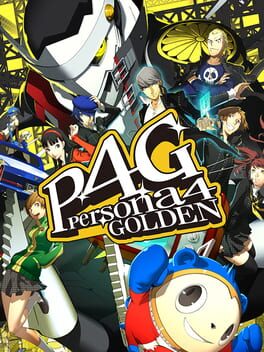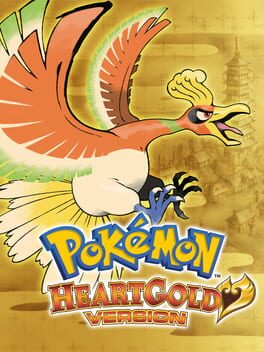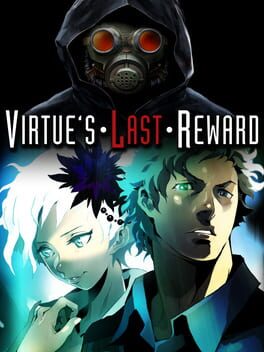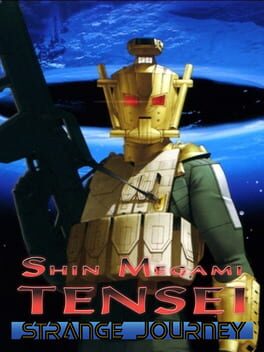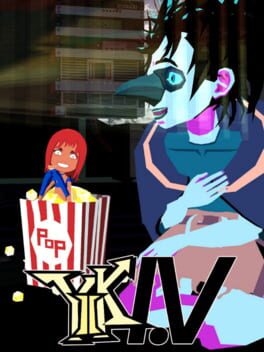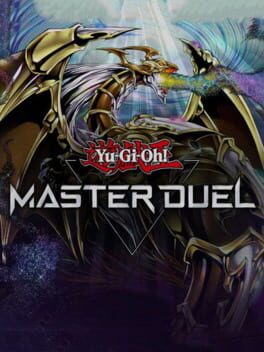Doyes
Bio
Nothing here!
Badges

Shreked
Found the secret ogre page

Roadtrip
Voted for at least 3 features on the roadmap
Favorite Games
058
Total Games Played
000
Played in 2024
012
Games Backloggd
Recently Reviewed See More
I figured I'd review the demo since I already laid out my thoughts on the original game (which you can read here.). I won't be giving a score for it, seeing as the full update isn't out yet, but from what Ackk Studios have shown so far with Nameless Psychosis, I've been pretty impressed. I have my doubts that this update will fix all of YIIK's problems, but at the very least I see this game becoming something that is fun to play.
The most immediate thing I noticed was the updated presentation. YIIK is doubling down on the weird imagery, now aided with more inventive camera angles. It still comes off as the developers trying way too hard to tell an abstract narrative, but I can at least appreciate what they're going for this time around. It's a notable improvement without veering too far away from their original art style. The UI also got a massive overhaul. What was once barren and a horrible slog to navigate, has now turned into something that I would describe as not only functional, but also imbued with much-needed character. This might sound like a back handed compliment, and in some respects it is, but I do appreciate the effort they put in reworking the UI. The only thing I wasn't a fan of was the new opening sequence. The visuals are fine, but the musical choice doesn't compliment the editing and it creates a disconnect. It seems like they were trying to recreate an anime opening, but they should have probably opted for a more energetic song than the one they ended up going with.
On the subject of music, Nameless Psychosis features some new tracks and I dig them quite a bit. The menu theme was the stand out track to me, going for a lounge type song that for some reason reminds me of The Cardigans. Maybe it's the lead singer that heavily reminds me of the Swedish pop group. The new tracks are much more subdued compared to the game's original tracks, which I think works in YIIK's benefit. They also seem to be more thematically consistent, instead of the "try out whatever the fuck we want" approach the original game went for.
The biggest upgrade that YIIK received in the demo is easily the combat. Gone are the days of having to play the most frustrating mini-games only to do minuscule amounts of damage. Instead, we get the Karta system. Characters now work with three card slots in which they can equip unique cards that give them battle abilities, stats and passive abilities. They also act as a shield from damage, and once they've been destroyed you'll eventually start taking regular damage. Once you get it with an attack with no more cards, you will enter a bleed state, where you begin to lose health as a battle progresses. The Karta system feels like a direct response to the criticism that the original combat system was incredibly slow and tenuous, and it at the very least makes combat much faster and more engaging. I worry that the system can become a bit overwhelming, as I don't think I had fully grasped it by the time I was done with the demo, but I at least came out of it much more positively. There's also the issue of readability when in the bleed state, as it was hard to figure out when your health would tick a point of HP or not. Hopefully they improve on this aspect of the combat, and if they do, they might have something special on their hands.
If there's anything that I wasn't sold on is the story. Many of the issues I had with the original story are still present here, with an added layer of abstract story telling. They seem to be setting something up with Rory's sister, possibly hinting that foul play was a foot, but the way it's been told is so far isn't winning me over. Alex is still the same, overly verbose and long-winded character that he was in the original, but this time they use a framing device when he's monologuing, having him essentially do so on a stand-up stage. I see this as both reinforcing the fact that he is this self-centered character, as he literally becomes the center of attention, as well as adding some visual flare to when he just rambles on and on. I feel this was a misguided attempt at conveying this idea to the player, but they do use these moments to deliver some genuine laughs (at least I think that's what they're doing). They seem to be leaning more into the fact that Alex has become a giant meme online, which does do a decent job at conveying that we probably shouldn't be taking him so seriously all the time.
I liked what I played, but I'm not entirely convinced that this will be the update that radically changes the perception of the game, at least from a story telling perspective. At most, I think this will be the best version of this story. Maybe I'm wrong, and the new story updates will blow me away and will dramatically change the quality of the story, but I'm somewhat doubtful of that. At least the game is fun to play this time around, which is already a massive improvement over the original.
The most immediate thing I noticed was the updated presentation. YIIK is doubling down on the weird imagery, now aided with more inventive camera angles. It still comes off as the developers trying way too hard to tell an abstract narrative, but I can at least appreciate what they're going for this time around. It's a notable improvement without veering too far away from their original art style. The UI also got a massive overhaul. What was once barren and a horrible slog to navigate, has now turned into something that I would describe as not only functional, but also imbued with much-needed character. This might sound like a back handed compliment, and in some respects it is, but I do appreciate the effort they put in reworking the UI. The only thing I wasn't a fan of was the new opening sequence. The visuals are fine, but the musical choice doesn't compliment the editing and it creates a disconnect. It seems like they were trying to recreate an anime opening, but they should have probably opted for a more energetic song than the one they ended up going with.
On the subject of music, Nameless Psychosis features some new tracks and I dig them quite a bit. The menu theme was the stand out track to me, going for a lounge type song that for some reason reminds me of The Cardigans. Maybe it's the lead singer that heavily reminds me of the Swedish pop group. The new tracks are much more subdued compared to the game's original tracks, which I think works in YIIK's benefit. They also seem to be more thematically consistent, instead of the "try out whatever the fuck we want" approach the original game went for.
The biggest upgrade that YIIK received in the demo is easily the combat. Gone are the days of having to play the most frustrating mini-games only to do minuscule amounts of damage. Instead, we get the Karta system. Characters now work with three card slots in which they can equip unique cards that give them battle abilities, stats and passive abilities. They also act as a shield from damage, and once they've been destroyed you'll eventually start taking regular damage. Once you get it with an attack with no more cards, you will enter a bleed state, where you begin to lose health as a battle progresses. The Karta system feels like a direct response to the criticism that the original combat system was incredibly slow and tenuous, and it at the very least makes combat much faster and more engaging. I worry that the system can become a bit overwhelming, as I don't think I had fully grasped it by the time I was done with the demo, but I at least came out of it much more positively. There's also the issue of readability when in the bleed state, as it was hard to figure out when your health would tick a point of HP or not. Hopefully they improve on this aspect of the combat, and if they do, they might have something special on their hands.
If there's anything that I wasn't sold on is the story. Many of the issues I had with the original story are still present here, with an added layer of abstract story telling. They seem to be setting something up with Rory's sister, possibly hinting that foul play was a foot, but the way it's been told is so far isn't winning me over. Alex is still the same, overly verbose and long-winded character that he was in the original, but this time they use a framing device when he's monologuing, having him essentially do so on a stand-up stage. I see this as both reinforcing the fact that he is this self-centered character, as he literally becomes the center of attention, as well as adding some visual flare to when he just rambles on and on. I feel this was a misguided attempt at conveying this idea to the player, but they do use these moments to deliver some genuine laughs (at least I think that's what they're doing). They seem to be leaning more into the fact that Alex has become a giant meme online, which does do a decent job at conveying that we probably shouldn't be taking him so seriously all the time.
I liked what I played, but I'm not entirely convinced that this will be the update that radically changes the perception of the game, at least from a story telling perspective. At most, I think this will be the best version of this story. Maybe I'm wrong, and the new story updates will blow me away and will dramatically change the quality of the story, but I'm somewhat doubtful of that. At least the game is fun to play this time around, which is already a massive improvement over the original.
The Halo series is one of those franchises that's reputation sort of overshadows the actual quality of the gameplay and narrative. For the longest time it was seen as the dude bro shooter (before getting dethroned by Call of Duty in that respect), which is a shame because this series under Bungie's direction was quite ambitious. You don't really see these sorts of stories in first-person shooters anymore. I've long since fallen off with the franchise, but the Bungie led entries will always occupy a certain corner of my brain.
Halo CE has a really strange start to its story when you think about it. You're already well into the convenant war, and it doesn't really explain what exactly is happening outside the most pressing matter. The Pillar of Autumn is on the run from a Convenant fleet, and eventually crash-land onto the ring world known as Halo. There you discover more secrets about the ring as the story and danger unravels in front of you. The game isn't especially long, but it utilizes its short run time to tell a pretty compelling story, while also planting the seeds of stuff that wouldn't get developed until much later. It's simple and effective, while also keeping a lot of the intrigue that Bungie's older games had.
Halo is arguably the game that made FPSs on consoles viable and incredibly popular, and for good reason. It laid the groundwork for a ton of mechanics that other games would implement in an attempt to capture even a fraction of Halo's success. Regenerating shields, once a novelty and very innovative, are basically the default nowadays and so many games use them. I can't imagine what the gaming landscape would look like without this game's existence. But that isn't the only reason why this game was successful. This game's first half is incredibly strong, with a good sense of escalation and forward momentum. The level design alone and approach to combat is what makes this game, and the rest of the Bungie led games, so special. Levels are open-ended enough where you can approach combat scenarios in a multitude of ways. The enemy AI is really something to behold, and on higher difficulties always keeps you on your toes with how aggressive and tactical they can be. The arsenal presented to you is diverse enough where most guns will provide a unique role, however some guns kind of feel underpowered and redundant. The Assault Rifle is especially guilty of this. Meant to be the human mid range weapon, your more often then not better off replacing it with the Covenant Plasma Rifle, or even the Plasma Pistol, which in this game is absurdly powerful. I'd also be remiss to not mention the Magnum Pistol, a gun so powerful that you're almost always happy to have one on hand, and that completely invalidates an enemy type. I'd say where the game falters is in the second half of the game. Once the new enemy type is introduced into the game, the levels become a horrible slog to go through and the difficulty spikes up quite intensely. It's somewhat redeemed by a very memorable final mission, but getting to that point can be an exercise in frustration.
The human character models look pretty outdated, even by 2001 standards. Stiff animation, puppet like mouth flaps, it's the one thing that holds this game back visually, which is a shame because the rest of the game still looks quite good. The Covenant designs are truly excellent, with great animations and audio barks. The environmental designs are also great, even if some of the textures can look outdated. At its worst, it looks of the time, but at its best I would think I was playing a modern game. On that note, I wouldn't recommend playing this game with the remastered graphics. While the attempt is noble, its way too overdesigned and often times would kill the mood of a given level. They make everything way too bright, and would add unnecessary flora to certain levels that actually has gameplay ramifications, as certain lines of sight become unusable,
The music in this game is simply put, legendary. Martin O'Donnell's score is at this point iconic, and once you hear it, it won't be leaving your head. There's a good reason why Gregorian choirs are so heavily associated with this game. It'd be one thing if the music was simply excellent, but the way it's implemented is what really elevates it. Bungie knew exactly when to play his score, so when you hear Truth And Reconciliation Suite kick in, you knew the moment was important.
Halo CE remains a really great first attempt at a 3D FPS by Bungie. They had years of experience with Marathon to get this right, and it paid off big time. It would launch them into levels of success beyond their wildest imaginations, and would lay the groundwork for their trajectory as a company. A lot of the ideas they had for the first game would be later refined in future entries, and while it might not always shine in the context of modern gaming sensibilities, I still think even more than 20 years it holds up.
Halo CE has a really strange start to its story when you think about it. You're already well into the convenant war, and it doesn't really explain what exactly is happening outside the most pressing matter. The Pillar of Autumn is on the run from a Convenant fleet, and eventually crash-land onto the ring world known as Halo. There you discover more secrets about the ring as the story and danger unravels in front of you. The game isn't especially long, but it utilizes its short run time to tell a pretty compelling story, while also planting the seeds of stuff that wouldn't get developed until much later. It's simple and effective, while also keeping a lot of the intrigue that Bungie's older games had.
Halo is arguably the game that made FPSs on consoles viable and incredibly popular, and for good reason. It laid the groundwork for a ton of mechanics that other games would implement in an attempt to capture even a fraction of Halo's success. Regenerating shields, once a novelty and very innovative, are basically the default nowadays and so many games use them. I can't imagine what the gaming landscape would look like without this game's existence. But that isn't the only reason why this game was successful. This game's first half is incredibly strong, with a good sense of escalation and forward momentum. The level design alone and approach to combat is what makes this game, and the rest of the Bungie led games, so special. Levels are open-ended enough where you can approach combat scenarios in a multitude of ways. The enemy AI is really something to behold, and on higher difficulties always keeps you on your toes with how aggressive and tactical they can be. The arsenal presented to you is diverse enough where most guns will provide a unique role, however some guns kind of feel underpowered and redundant. The Assault Rifle is especially guilty of this. Meant to be the human mid range weapon, your more often then not better off replacing it with the Covenant Plasma Rifle, or even the Plasma Pistol, which in this game is absurdly powerful. I'd also be remiss to not mention the Magnum Pistol, a gun so powerful that you're almost always happy to have one on hand, and that completely invalidates an enemy type. I'd say where the game falters is in the second half of the game. Once the new enemy type is introduced into the game, the levels become a horrible slog to go through and the difficulty spikes up quite intensely. It's somewhat redeemed by a very memorable final mission, but getting to that point can be an exercise in frustration.
The human character models look pretty outdated, even by 2001 standards. Stiff animation, puppet like mouth flaps, it's the one thing that holds this game back visually, which is a shame because the rest of the game still looks quite good. The Covenant designs are truly excellent, with great animations and audio barks. The environmental designs are also great, even if some of the textures can look outdated. At its worst, it looks of the time, but at its best I would think I was playing a modern game. On that note, I wouldn't recommend playing this game with the remastered graphics. While the attempt is noble, its way too overdesigned and often times would kill the mood of a given level. They make everything way too bright, and would add unnecessary flora to certain levels that actually has gameplay ramifications, as certain lines of sight become unusable,
The music in this game is simply put, legendary. Martin O'Donnell's score is at this point iconic, and once you hear it, it won't be leaving your head. There's a good reason why Gregorian choirs are so heavily associated with this game. It'd be one thing if the music was simply excellent, but the way it's implemented is what really elevates it. Bungie knew exactly when to play his score, so when you hear Truth And Reconciliation Suite kick in, you knew the moment was important.
Halo CE remains a really great first attempt at a 3D FPS by Bungie. They had years of experience with Marathon to get this right, and it paid off big time. It would launch them into levels of success beyond their wildest imaginations, and would lay the groundwork for their trajectory as a company. A lot of the ideas they had for the first game would be later refined in future entries, and while it might not always shine in the context of modern gaming sensibilities, I still think even more than 20 years it holds up.
I hesitate to give Master Duel a rating by nature of it being both 1) a live service game and 2) a card game that constantly evolves. Any rating that I give now can just as quickly be made irrelevant by a future update that changes the in game economy or the introduction and removal of cards that can change the meta in a moment. For that reason, I'm going to keep this to the current state of the game, while ignoring format specific issues. Lord knows how many people love to complain about the current meta threat.
So I'm going to get this out of the way right now, the biggest issue with Master Duel is the existence of Maxx "C". I have no idea why Konami is seemingly so in love with this card, but it's incredibly unhealthy for the game and warps deck building. You basically have to dedicate a quarter of your deck list to account for this card. While banning it won't solve all the games issues, it would do a lot to lessen the impact of them.
The game is also not very good at onboarding new players. Yu-Gi-Oh is an incredibly complicated game to learn and master, and Master Duel does a very inadequate job at teaching people how to play the game. The tutorial will teach you very basic stuff about the game, but beyond that you're shit out of luck. Solo Mode can maybe provide a better learning experience for certain archetypes, but if none of them interest you, then that's that. The best thing you can do to learn is find a deck that interests you and look up a guide on Youtube on how best to play it. In my experience, it doesn't take that long for me to learn the fundamentals of a new deck, but this will vary wildly from person to person.
The best of one format is also not an ideal way to play a game, especially in a ladder format. I get why that's the case, as games would drag on for much longer if ladder was in a BO3 format with side decking, but it would do a lot to encourage skilful play and deck building instead of simply building a deck that can generate a 51% win rate.
So does Master Duel anything good compared to paper play. Shockingly, yes. In a strange turn of events, Konami created a game with one of the most generous economies I've experienced. You can make competitively viable decks without ever needing to spend a dime to do so. This is made easier by the fact that the game has a crafting system, where you can just craft the cards you need for any strategy and dismantle cards you'll never use. Don't want to spend hundreds if not thousands of gems in the hopes to pull a one of UR? Just craft that sucker. It also helps that a lot of the expensive cards are staples that you'll run across many decks, so the true cost to build a new deck is never as high as it might seem. Master Duel also only uses one type of currency, and that currency can be easily earned by just playing the game. In a world where the TCG can often times be prohibitively expensive, it's nice to see a way to play these decks without needing to remortgage your house.
Another feature that keeps the level of investment low is the game's various starter decks. For 1500 gems, you can run some pretty decent decks. They aren't Tier 1 meta threats, mind you, but some of the Starter Decks on offer are at the very least viable to play on the ladder, which means that you don't need to invest all that much to get a head start on your climb up the ladder. Just do your due diligence and do some research on which decks are worth getting before taking the plunge.
I can't say whether Master Duel is a good way to experience Yu-Gi-Oh as it's so heavily dependent on the type of person you are. If you're looking for a way to just do pick up and play type Yu-Gi-Oh, this is not the product for you. If you're looking to more seriously get into the game while also not wanting to break the bank on cardboard, Master Duel could provide a good alternative for that itch.
So I'm going to get this out of the way right now, the biggest issue with Master Duel is the existence of Maxx "C". I have no idea why Konami is seemingly so in love with this card, but it's incredibly unhealthy for the game and warps deck building. You basically have to dedicate a quarter of your deck list to account for this card. While banning it won't solve all the games issues, it would do a lot to lessen the impact of them.
The game is also not very good at onboarding new players. Yu-Gi-Oh is an incredibly complicated game to learn and master, and Master Duel does a very inadequate job at teaching people how to play the game. The tutorial will teach you very basic stuff about the game, but beyond that you're shit out of luck. Solo Mode can maybe provide a better learning experience for certain archetypes, but if none of them interest you, then that's that. The best thing you can do to learn is find a deck that interests you and look up a guide on Youtube on how best to play it. In my experience, it doesn't take that long for me to learn the fundamentals of a new deck, but this will vary wildly from person to person.
The best of one format is also not an ideal way to play a game, especially in a ladder format. I get why that's the case, as games would drag on for much longer if ladder was in a BO3 format with side decking, but it would do a lot to encourage skilful play and deck building instead of simply building a deck that can generate a 51% win rate.
So does Master Duel anything good compared to paper play. Shockingly, yes. In a strange turn of events, Konami created a game with one of the most generous economies I've experienced. You can make competitively viable decks without ever needing to spend a dime to do so. This is made easier by the fact that the game has a crafting system, where you can just craft the cards you need for any strategy and dismantle cards you'll never use. Don't want to spend hundreds if not thousands of gems in the hopes to pull a one of UR? Just craft that sucker. It also helps that a lot of the expensive cards are staples that you'll run across many decks, so the true cost to build a new deck is never as high as it might seem. Master Duel also only uses one type of currency, and that currency can be easily earned by just playing the game. In a world where the TCG can often times be prohibitively expensive, it's nice to see a way to play these decks without needing to remortgage your house.
Another feature that keeps the level of investment low is the game's various starter decks. For 1500 gems, you can run some pretty decent decks. They aren't Tier 1 meta threats, mind you, but some of the Starter Decks on offer are at the very least viable to play on the ladder, which means that you don't need to invest all that much to get a head start on your climb up the ladder. Just do your due diligence and do some research on which decks are worth getting before taking the plunge.
I can't say whether Master Duel is a good way to experience Yu-Gi-Oh as it's so heavily dependent on the type of person you are. If you're looking for a way to just do pick up and play type Yu-Gi-Oh, this is not the product for you. If you're looking to more seriously get into the game while also not wanting to break the bank on cardboard, Master Duel could provide a good alternative for that itch.
